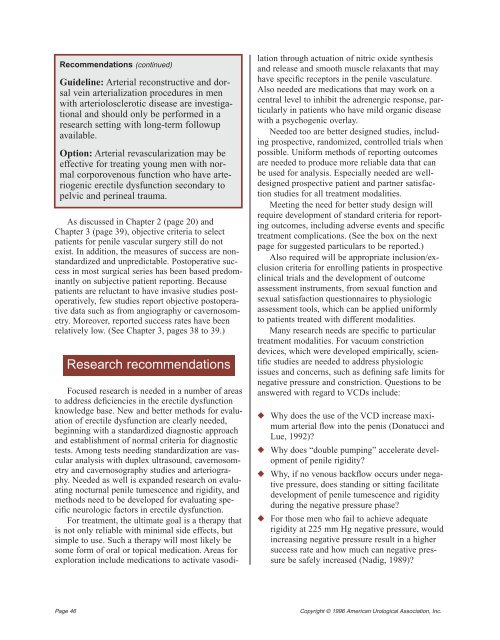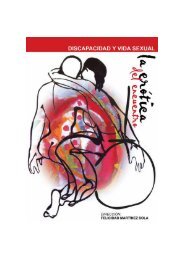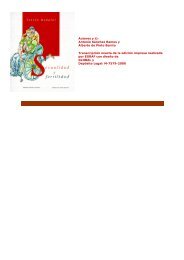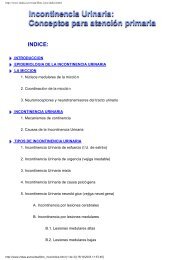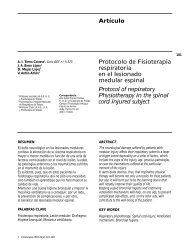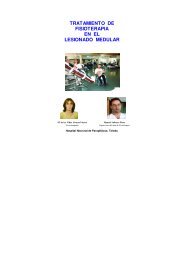The American Urological Association Erectile Dysfunction ... - Vastim
The American Urological Association Erectile Dysfunction ... - Vastim
The American Urological Association Erectile Dysfunction ... - Vastim
Create successful ePaper yourself
Turn your PDF publications into a flip-book with our unique Google optimized e-Paper software.
Recommendations (continued)Guideline: Arterial reconstructive and dorsalvein arterialization procedures in menwith arteriolosclerotic disease are investigationaland should only be performed in aresearch setting with long-term followupavailable.Option: Arterial revascularization may beeffective for treating young men with normalcorporovenous function who have arteriogenicerectile dysfunction secondary topelvic and perineal trauma.As discussed in Chapter 2 (page 20) andChapter 3 (page 39), objective criteria to selectpatients for penile vascular surgery still do notexist. In addition, the measures of success are nonstandardizedand unpredictable. Postoperative successin most surgical series has been based predominantlyon subjective patient reporting. Becausepatients are reluctant to have invasive studies postoperatively,few studies report objective postoperativedata such as from angiography or cavernosometry.Moreover, reported success rates have beenrelatively low. (See Chapter 3, pages 38 to 39.)Research recommendationsFocused research is needed in a number of areasto address deficiencies in the erectile dysfunctionknowledge base. New and better methods for evaluationof erectile dysfunction are clearly needed,beginning with a standardized diagnostic approachand establishment of normal criteria for diagnostictests. Among tests needing standardization are vascularanalysis with duplex ultrasound, cavernosometryand cavernosography studies and arteriography.Needed as well is expanded research on evaluatingnocturnal penile tumescence and rigidity, andmethods need to be developed for evaluating specificneurologic factors in erectile dysfunction.For treatment, the ultimate goal is a therapy thatis not only reliable with minimal side effects, butsimple to use. Such a therapy will most likely besome form of oral or topical medication. Areas forexploration include medications to activate vasodilationthrough actuation of nitric oxide synthesisand release and smooth muscle relaxants that mayhave specific receptors in the penile vasculature.Also needed are medications that may work on acentral level to inhibit the adrenergic response, particularlyin patients who have mild organic diseasewith a psychogenic overlay.Needed too are better designed studies, includingprospective, randomized, controlled trials whenpossible. Uniform methods of reporting outcomesare needed to produce more reliable data that canbe used for analysis. Especially needed are welldesignedprospective patient and partner satisfactionstudies for all treatment modalities.Meeting the need for better study design willrequire development of standard criteria for reportingoutcomes, including adverse events and specifictreatment complications. (See the box on the nextpage for suggested particulars to be reported.)Also required will be appropriate inclusion/exclusioncriteria for enrolling patients in prospectiveclinical trials and the development of outcomeassessment instruments, from sexual function andsexual satisfaction questionnaires to physiologicassessment tools, which can be applied uniformlyto patients treated with different modalities.Many research needs are specific to particulartreatment modalities. For vacuum constrictiondevices, which were developed empirically, scientificstudies are needed to address physiologicissues and concerns, such as defining safe limits fornegative pressure and constriction. Questions to beanswered with regard to VCDs include:◆ Why does the use of the VCD increase maximumarterial flow into the penis (Donatucci andLue, 1992)?◆ Why does “double pumping” accelerate developmentof penile rigidity?◆ Why, if no venous backflow occurs under negativepressure, does standing or sitting facilitatedevelopment of penile tumescence and rigidityduring the negative pressure phase?◆ For those men who fail to achieve adequaterigidity at 225 mm Hg negative pressure, wouldincreasing negative pressure result in a highersuccess rate and how much can negative pressurebe safely increased (Nadig, 1989)?Page 46Copyright © 1996 <strong>American</strong> <strong>Urological</strong> <strong>Association</strong>, Inc.


